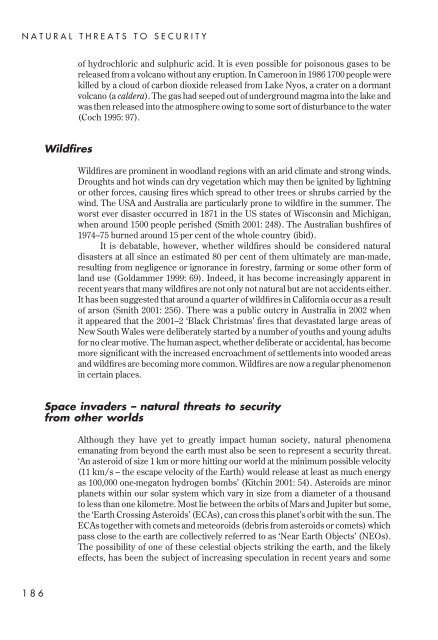Understanding global security - Peter Hough
Understanding global security - Peter Hough
Understanding global security - Peter Hough
You also want an ePaper? Increase the reach of your titles
YUMPU automatically turns print PDFs into web optimized ePapers that Google loves.
NATURAL THREATS TO SECURITY<br />
of hydrochloric and sulphuric acid. It is even possible for poisonous gases to be<br />
released from a volcano without any eruption. In Cameroon in 1986 1700 people were<br />
killed by a cloud of carbon dioxide released from Lake Nyos, a crater on a dormant<br />
volcano (a caldera). The gas had seeped out of underground magma into the lake and<br />
was then released into the atmosphere owing to some sort of disturbance to the water<br />
(Coch 1995: 97).<br />
Wildfires<br />
Wildfires are prominent in woodland regions with an arid climate and strong winds.<br />
Droughts and hot winds can dry vegetation which may then be ignited by lightning<br />
or other forces, causing fires which spread to other trees or shrubs carried by the<br />
wind. The USA and Australia are particularly prone to wildfire in the summer. The<br />
worst ever disaster occurred in 1871 in the US states of Wisconsin and Michigan,<br />
when around 1500 people perished (Smith 2001: 248). The Australian bushfires of<br />
1974–75 burned around 15 per cent of the whole country (ibid).<br />
It is debatable, however, whether wildfires should be considered natural<br />
disasters at all since an estimated 80 per cent of them ultimately are man-made,<br />
resulting from negligence or ignorance in forestry, farming or some other form of<br />
land use (Goldammer 1999: 69). Indeed, it has become increasingly apparent in<br />
recent years that many wildfires are not only not natural but are not accidents either.<br />
It has been suggested that around a quarter of wildfires in California occur as a result<br />
of arson (Smith 2001: 256). There was a public outcry in Australia in 2002 when<br />
it appeared that the 2001–2 ‘Black Christmas’ fires that devastated large areas of<br />
New South Wales were deliberately started by a number of youths and young adults<br />
for no clear motive. The human aspect, whether deliberate or accidental, has become<br />
more significant with the increased encroachment of settlements into wooded areas<br />
and wildfires are becoming more common. Wildfires are now a regular phenomenon<br />
in certain places.<br />
Space invaders – natural threats to <strong>security</strong><br />
from other worlds<br />
Although they have yet to greatly impact human society, natural phenomena<br />
emanating from beyond the earth must also be seen to represent a <strong>security</strong> threat.<br />
‘An asteroid of size 1 km or more hitting our world at the minimum possible velocity<br />
(11 km/s – the escape velocity of the Earth) would release at least as much energy<br />
as 100,000 one-megaton hydrogen bombs’ (Kitchin 2001: 54). Asteroids are minor<br />
planets within our solar system which vary in size from a diameter of a thousand<br />
to less than one kilometre. Most lie between the orbits of Mars and Jupiter but some,<br />
the ‘Earth Crossing Asteroids’ (ECAs), can cross this planet’s orbit with the sun. The<br />
ECAs together with comets and meteoroids (debris from asteroids or comets) which<br />
pass close to the earth are collectively referred to as ‘Near Earth Objects’ (NEOs).<br />
The possibility of one of these celestial objects striking the earth, and the likely<br />
effects, has been the subject of increasing speculation in recent years and some<br />
186
















